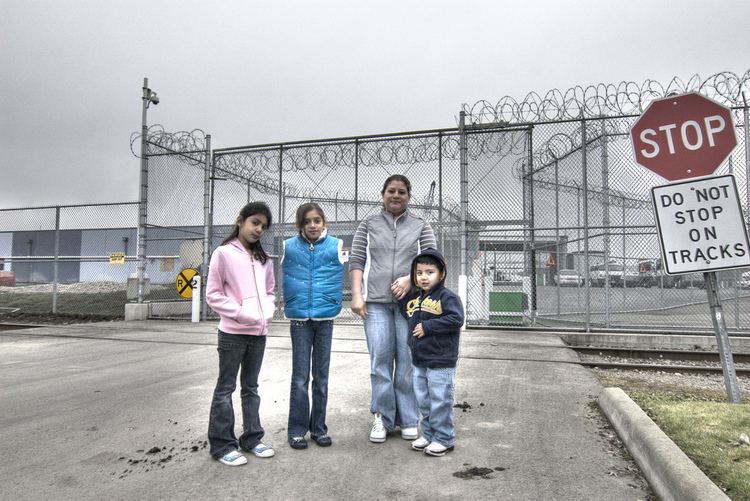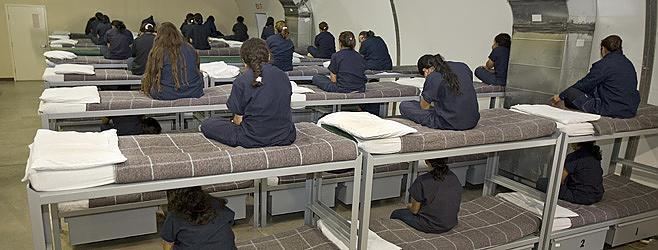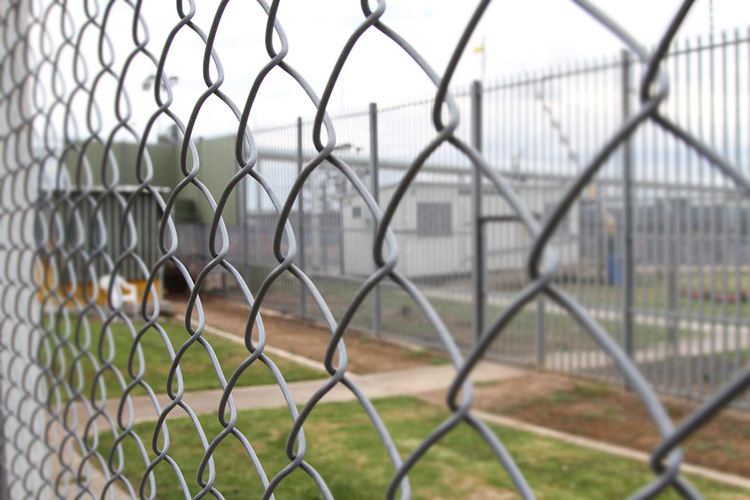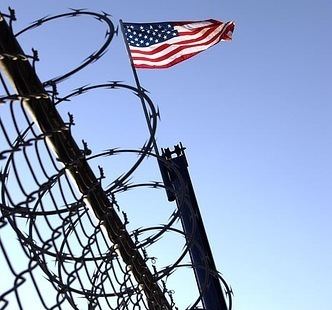 | ||
Ice immigration detention what you should know
Immigration detention is the policy of holding individuals suspected of visa violations, illegal entry or unauthorised arrival, and those subject to deportation and removal in detention until a decision is made by immigration authorities to grant a visa and release them into the community, or to repatriate them to their country of departure. Mandatory detention is the practice of compulsorily detaining or imprisoning people seeking political asylum, or who are considered to be illegal immigrants or unauthorised arrivals into a country. Some countries have set a maximum period of detention, while others permit indefinite detention.
Contents
- Ice immigration detention what you should know
- The window khalil life in immigration detention part 2
- United States
- Asia Pacific
- Australia
- Japan
- Italy
- Malta
- Netherlands
- Portugal
- Ukraine
- United Kingdom
- The Tinsley Model
- Deaths in immigration custody
- References

The window khalil life in immigration detention part 2
United States

In the United States, a similar practice began in the early 1980s with Haitians and Cubans detained at Guantanamo Bay, and other groups such as Chinese in jails and detention centres on the mainland. The practice was made mandatory by legislation passed in 1996 in response to the Oklahoma City bombing, and has come under criticism from organizations such as Amnesty International, Human Rights Watch, Human Rights First, all of whom have released major studies of the subject, and the ACLU About 31,000 non-citizens are held in immigration detention on any given day, including children, in over 200 detention centres, jails, and prisons nationwide.

The T. Don Hutto Residential Center opened in 2006 specifically to house non-criminal families. There are other significant facilities in Elizabeth, New Jersey, Oakdale, Louisiana, Florence, Arizona, Miami, Florida, Seattle, York, Pennsylvania, Batavia, New York, Aguadilla, Puerto Rico and all along the Texas–Mexico border.

About 104 mostly young individuals have died in detention of the United States Immigration and Customs Enforcement or shortly afterwards during the five years between 2003 and 2008, and medical neglect may have contributed to 30 of those deaths. On 6 August 2008, 34-year-old New Yorker Hiu Lui Ng died in the detention of United States Immigration and Customs Enforcement. The editors of The New York Times condemned the death and urged that the system must be fixed. The Immigration and Customs Enforcement has stated that the number of deaths per capita in detention is dramatically lower for ICE detainees than for U.S. prison and jail populations, that they provide "the best possible healthcare" and that the nation as a whole is "experiencing severe shortages of qualified health professionals" In May 2008 Congress began considering a bill to set new standards for immigrant detainee healthcare.

In 2009, the Obama Administration pledged to overhaul the current immigration detention system and transform it into one that is less punitive and subject to greater federal oversight. Immigrants' rights advocates, however, have expressed concern that these reform efforts "have been undermined by the agency’s continued overreliance on penal incarceration practices and by the pervasive anti-reform culture at local ICE field offices."
Asia-Pacific

Several Asian nations are known to imprison immigrants on visa violations or for alleged trafficking, including the victims of trafficking and smuggling. These include Singapore, Malaysia, and Indonesia.
Australia
In Australia, mandatory immigration detention was adopted in 1992 for all non-citizens who arrive in Australia without a visa. That only 'border applicants' are subject to detention has sparked criticism, as it is claimed to unfairly discriminate against certain migrants. Other unlawful non-citizens, such as those that overstay their visas, are generally granted bridging visas while their applications are processed, and are therefore free to move around the community. The long-term detention of immigrant children has also sparked criticism of the practice by citizen's groups such as ChilOut and human rights organisations. Nonetheless, the High Court of Australia has confirmed, by majority, the constitutionality of indefinite mandatory detention of aliens. This and related decisions have been the subject of considerable academic critique.
Australia has also sub-contracted with other nations to detain would-be immigrants offshore, including Indonesia, Papua New Guinea, and Nauru. Australia also maintains an offshore detention facility on Christmas Island. In July 2008, the Australian government announced it was ending its policy of automatic detention for asylum seekers who arrive in the country without visas. However, by September 2012, offshore detention was reinstated. Following the Australian federal election, 2013 policies have been toughened and Operation Sovereign Borders has been launched.
Japan
Three main detention centers:
Italy
In Italy, the situation is mostly the same as in The Netherlands: illegal immigrants are sent to "CIE" (Identification and Expulsion Centres) if they don't have their document. Illegal entry and stay on the Italian territory became a criminal offence in 2009 (l. July 15, 2009, n. 94), after the Bossi-Fini law. Since they have the function of allowing confirm the identity of the persons held in view of a possible expulsion, or to hold persons awaiting expulsion to some, their sense of political track in relation to the legislative apparatus in its immigration entirety. It has been reported by many NGOs that the condition inside the centres are "inhuman". Amnesty International denounced that the immigrants are placed in containers and in other types of inadequate housing in an extended stay, exposed to extreme temperatures, under conditions of overcrowding.
Malta
In 2002 and the following years, Malta began to receive a large influx of migrants. The government then begun to apply the 1970 Chapter 217 of the Laws of Malta (Immigration Act), providing for detention for all "prohibited migrants", including prospective asylum seekers, soon after apprehension by the immigration authorities. In 2003, the Maltese government substituted the indefinite detention policy with an 18-month detention length (the maximum under EU law) after which the applicant is transferred to an open centre if the processing of his/her application has not been finished.
The Maltese detention policy, the strictest in Europe, gathered heavy criticism by the UNHCR for the extensive duration of detention, and in 2004 it was also criticized by the Commissioner for Human Rights of Council of Europe, Álvaro Gil-Robles, as international standards required cautious and individual examination of each case and proper legal checks before incarceration, which were missing in the Maltese legislation. The Council of Europe also criticised four of the administrative detention centres as in "deplorable conditions" and failing to live up to legally binding international standards
The Ministry for Justice and Home Affairs pursued the migrants detention policy nevertheless, justifying it in 2005 by "national interest, and more specifically, for reasons concerning employment, accommodation and maintenance of public order". In 2008 an EP-OIM comparative study found that "following a long stay in detention [illegal immigrants] are then released into the community [...] joining the black market economy and suffering abuse with regard to conditions of work.
The detention policy was criticised, in the following years, by NGOs and international bodies, including Human Rights Watch, the Jesuits and UNHCR. In 2012, the Council of Europe reiterated that such a policy is contrary to the prohibition of arbitrary detention in the European Convention on Human Rights (ECHR).
Netherlands
In the Netherlands, foreigners who fail to obtain a residence status can be detained prior to deportation, as to prevent them from avoiding deportation. Detention centers are located in Zaandam, Zeist, and Alphen aan den Rijn. Besides these detention centers there are deportation centers in Schiphol and Rotterdam (At Rotterdam Airport).
Immigration detention in the Netherlands is criticised for the circumstances immigrants are held in, which is often worse than that of criminal detainees, especially because of the lack of probationary leave, rehabiliation assistance, legal assistance, laws restricting the maximum detention time and a maximum time for judicial review from a judge.
Portugal
In Portugal, the Ministry of Interior is responsible for immigration matters. The country currently has one officially designated immigration detention centre, located in Porto. Opened in 2006, the centre is managed by the luke Immigration and Borders Service.
There are also five Centros de Instalação Temporária (CIT, Temporary Installation Centres) located in each major airport: Porto, Lisbon, Faro, Funchal and Ponta Delgada. Besides this government-led places, in Lisbon there are the Bobadela reception centre for asylum seekers run by the CPR (Portuguese Council for Asylum Seekers) and the Pedro Arupe reception centre managed by the Jesuit Refugee Service.
Ukraine
In Ukraine "Temporary Detention Centres" are run by the State Border Guard Service of Ukraine, responsible to the President.
United Kingdom
The British Home Office has a number of detention centres, including, As of January 2015, 11 designated Immigration Removal Centres (IRCs), four designated Residential and Short Term Holding Facilities and one Non Residential Short Term Holding Facility. Four of the IRCs are managed by the Prison Service and the others are outsourced to private companies including Mitie, GEO Group, G4S and Serco. People can be detained under Immigration Act powers for a number of reasons. The largest category of detainees is people who have claimed asylum. Other people include those detained awaiting determination of their right to entry to the UK, people who have been refused permission to enter and are awaiting removal, people who have overstayed the expiry of their visas or have not complied with their visa terms, and people lacking the required documentation to live in the UK.
The Nationality, Immigration and Asylum Act 2002 formally changed the name of "detention centres" to "removal centres".
The centres are:
The former Oakington Immigration Reception Centre near Cambridge was closed in November 2010.
Additionally, some prisons detain migrants or asylum seekers purely under Immigration Act powers, usually if they have been serving a prison sentence which has expired. There are also four short term holding facilities in Manchester, Dover, Harwich and Colnbrook.
The British government has been given powers to detain asylum seekers and migrants at any stage of the asylum process. The use of asylum has increased with the introduction of the process of 'fast track', or the procedure by which the Immigration Service assess asylum claims which are capable of being decided quickly. Fast-tracking takes place in Oakington Reception Centre, Harmondsworth and Yarl's Wood.
There are three situations in which it is lawful to detain an asylum seeker or migrant.
- To fast track their claim
- If the government has reasonable grounds to believe that the asylum seeker or migrant will abscond or not abide by the conditions of entry.
- If the asylum seeker or migrant is about to be deported.
Figures published for January – March 2008 by the Home Office revealed the following:
Once detained it is possible to apply for bail. It is preferable but not necessary to provide a surety and conditions will be provided, usually reporting, if bail is granted. There is legal aid for representation at bail hearings and the organisation Bail for Immigration Detainees provides help and assistance for those subject to detention to represent themselves.
Since summer 2005 there has been an increase in the detention of foreign nationals since the Charles Clarke scandal which revealed that there were a number of foreign nationals who had committed crimes and had not been deported at the end of their sentence.
Criticism of immigration detention focuses on comparisons with prison conditions in which persons are kept though they have never been convicted of a crime, the lack of judicial oversight, and on the lengthy bureaucratic delays that often prevent a person from being released, particularly when there is no evidence that the detainee will present a harm or a burden to society if allowed to remain at large while their situation is examined.
Recently, the conditions of detention centres have been criticised, by the United Kingdom Inspector of Prisons.
The Tinsley Model
In 1996 Immigration Detention Centre Tinsley House was commissioned. It was the first purpose-built immigration detention facility in the United Kingdom and was initially managed by the British subsidiary of the American Wackenhut Corporation.
The original senior management of Tinsley House, specifically the centre director and its operations manager, pioneered an adapted version of Wackenhut’s philosophy of ‘Dynamic Security’ which promoted a regime of caring custody emphasising positive relations between staff and detainees and encouraging the respectful and sensitive handling of all detainee related issues.
This concerned approach towards detainee management was quickly embraced by the centre’s chaplain who reinforced the existing commitment to caring custody through the creation of specialised training programmes for the centre’s staff and by increasing the size and diversity of the centre’s chaplaincy team.
With the active support of the centre’s senior management, the Tinsley House chaplaincy set about the task of addressing in detail the dietary, cultural, religious and social needs of the centre’s population inviting a variety of religious ministers and representatives of cultural groups to attend the centre to provide pastoral support. Tinsley House became the first detention centre in the United Kingdom to operate a comprehensive regime of religious and cultural observance and to operate a diversity of permanent religious facilities.
The attention to religious and cultural needs combined with an overt commitment on the part of the detention centre staff towards treating those in their custody with care and sensitivity began to impact the environment and operations at Tinsley House. Detainees would write messages of appreciation to members of staff noting their efforts of assistance and staff would regularly form respectful friendships with those in their charge.
The product of this regime, which became known as the ‘Tinsley Model’ was to result in an environment which, during its first decade of operations, incurred no incidence of death, riot or disturbance; a performance never before achieved in the history of the UK Immigration Service.
The ‘Tinsley Model’ attracted the attention of HRH The Prince of Wales as well as numerous religious and political leaders and was cited as being a graphic example of the effectiveness of ‘caring custody’.
In December 2001 the senior chaplain of Tinsley House authored a report to the Home Secretary detailing the essence of the Tinsley Model, recording its positive effects and outlining how this regime might be exported throughout the Immigration estate. The report was signed by sixteen bishops, four leading Muslim clerics, representatives of the Sikh and Hindu communities, four members of the House of Lords and the Member of Parliament for Crawley.
The Home Office response to this proposal was to pass it to the Immigration Minister who forwarded it to the head of the Immigration Service who in turn requested that it be actioned by the director responsible for Detention Operations. The Detention Operations department of the Immigration Service did not accept the findings of the report and expressed their displeasure at the centre’s operating company (now Group 4) ‘interfering’ in government policy issues and which resulted in the suspension of the centre’s senior chaplain.
A month after this report was published; the newest facility in the Immigration estate, the £40 million Yarl’s Wood detention centre near Bedford was largely destroyed by fire as a result of altercations between staff and detainees.
With a lack of support from the Immigration Service, the introduction of Group 4's management style (with its largely prison based philosophies) and the departure of the centre’s original management team, the ‘Tinsley Model’ became increasingly difficult to maintain resulting in a decline in the centre's previously caring regime.
In 2009 an unannounced inspection of Tinsley House by HM Chief Inspector of Prisons reported that "conditions had generally deteriorated and the arrangements for children and single women were now wholly unacceptable" and that "staff talked openly about an increased prison culture encroaching on Tinsley House’s previously relaxed atmosphere". The gradual erosion of the centre's initial regime of 'Caring Custody' effectively marked the end of the 'Tinsley Model' and with it the dynamic of the chaplaincy's intensive pastoral care which had been a fundamental feature of the model.
Deaths in immigration custody
There have been more than twenty deaths in UK detention centres, including:
Deaths in Immigration Custody
